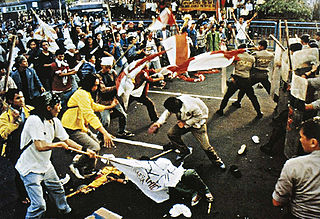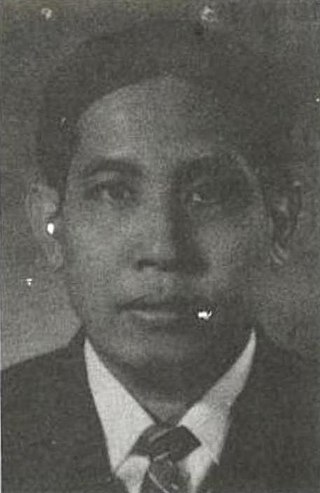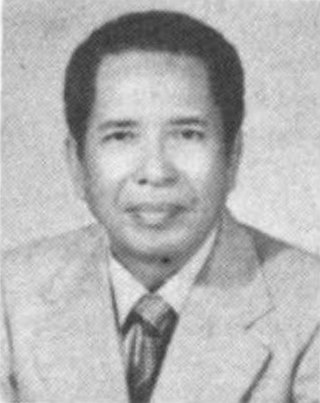
Suharto resigned as President of Indonesia on 21 May 1998 following the collapse of support for his 32-year long presidency. Vice President B. J. Habibie took over the presidency.

The May 1998 Indonesia riots, also known in Indonesia as the 1998 tragedy or simply the 1998 event, were incidents of mass violence, anti-government demonstrations, and civil unrest in Indonesia in May 1998. The events were mainly in the cities of Medan, Jakarta and Surakarta, with small incidents in other regions of the country.

Hutomo Mandala Putra, commonly known as Tommy Suharto, is an Indonesian businessman and politician. The youngest son of Suharto, the second President of Indonesia, he has long had a reputation of nepotism, corruption, and being a playboy. He gained notoriety for orchestrating the assassination of a judge who convicted him of corruption. He was convicted of murder in 2002 and sentenced to 15 years imprisonment, but was paroled in under four years.

Trisakti University is Indonesia's largest private university located in Jakarta, Indonesia. Trisakti University, is the only private university in Indonesia which was established by the Government of the Republic of Indonesia. Founded on 29 November 1965, the university has more than 20,000 active students and has produced more than 100,000 alumni. Trisakti University currently employs 742 tenured faculty members (82%) and 160 part-time lecturers (18%).

Harmoko, colloquially referred to as Bung Harmoko, was an Indonesian politician and journalist who was active during the New Order era. He served as the Speaker of the People's Representative Council from 1997 until 1999, and was a factor in president Suharto's resignation during the widespread student demonstrations which occurred at the end of the New Order.

Sofjan Wanandi, a.k.a. Lim Bian Khoen is an Indonesian businessman and the majority owner of Santini Group. Born in Sawahlunto, West Sumatra, he is the brother of Jusuf Wanandi, a senior politician and one of the founders of the CSIS think tank in Jakarta.

Trisakti Museum or May 12 Tragedy Museum is a human rights museum in Jakarta, Indonesia. The museum documents the active role of Indonesian students at Trisakti University in fighting for democracy and human rights.
The Berkarya Party is an Indonesian political party formed in 2016. The party was formed to channel the political aspirations of former president Suharto's youngest son, Hutomo Mandala Putra, better known as Tommy Suharto. Tommy, a convicted murderer by proxy, lost the general chairmanship of the party in July 2020 after the government recognized the leadership of a breakaway faction headed by former general Muchdi Purwopranjono. Berkarya came 11th out of 16 political parties that contested Indonesia's 2019 general election, receiving 2.09% of votes cast. The party supported Tommy's former brother-in-law Prabowo Subianto's unsuccessful bid for the presidency in 2019. After failing to win a 4% threshold necessary to gain seats in the national parliament, the party in 2020 split into rival factions: one led by Tommy and the government-recognized faction led by Muchdi.

Alya Rohali is an Indonesian film and soap opera actress, television show host, notary, model and a beauty pageant titleholder, who was crowned Puteri Indonesia 1996, She represented Indonesia at the Miss Universe 1996 pageant. She was the first person to hold the title of Puteri Indonesia to hold the title for four consecutive years.

A series of mass protests led by students took place at major cities in Indonesia from 23 September 2019, to rally against new legislation that reduces the authority of the Corruption Eradication Commission (KPK), as well as several bills including a new criminal code that penalises extramarital sex and defamation against the president. The protesters consisted of mostly students from over 300 universities, with no association with any particular political parties or groups. The protests were the most prominent student movement in Indonesia since the 1998 riots that brought down the Suharto regime.

Super East Java derby is the name given in football rivalries to any match between two Indonesian football clubs: Arema (Galatama) and Persebaya Surabaya (Perserikatan). The fierce competition between both teams began in 1992 when Arema and Persebaya Surabaya were grouped together in 1992 Piala HUT Arema.
The Semanggi shootings in Jakarta, Indonesia, were two incidents when state troops opened fire on unarmed civilians and protesters during special sessions of parliament. The first incident, known as Semanggi I, took place on 13 November 1998 and 17 people were killed. The second incident, Semanggi II, took place on 24 September 1999 and 12 people were killed and more than 200 wounded.

Soekisno Hadikoemoro was a physician who served as the 5th rector of the Cenderawasih University from 1970 until 1974.

Busiri Suryowinoto was an Indonesian military officer and politician who served as the Indonesian ambassador to Papua New Guinea from 1977 until 1980, and as the governor of Irian Jaya from 1981 until 1982.

Antonius Josef Witono Sarsanto was an Indonesian military officer and diplomat who became the Ambassador of Indonesia to Japan.

Haris Azhar is an Indonesian human rights activist. He served as the coordinator of the Commission for the Disappeared and Victims of Violence (KontraS) during 2010-2016. He is also a founder of the Jakarta-based NGO, Lokataru.
The following lists events that happened during 1998 in Indonesia.

Saleh Djasit is an Indonesian politician and military officer who served as the governor of Riau between 1998 and 2003, and as a member of the People's Representative Council from 1997 to 1998 and 2004 to 2008. He was also regent of Kampar Regency between 1986 and 1996. He was arrested and sentenced to four years in prison in 2008 for a corruption case, although he was released on parole after 2.5 years.

Ismail Suko was an Indonesian politician and civil servant. He served as a member of the People's Representative Council from 1987 to 1992, after previously serving in the provincial legislature and civil service of Riau. He had been elected as governor by legislature vote in 1985, but was forced to resign in favor of the government-selected candidate Imam Munandar.

Muhammad Kamil Tadjudin was an Indonesian physician and professor in medical biology. He served as the Rector of the University of Indonesia (UI) from 1994 until 1998.



















